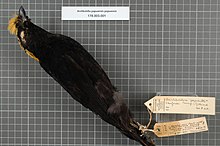Archbold's bowerbird
| Archbold's bowerbird | |
|---|---|

| |
| Scientific classification | |
| Kingdom: | Animalia |
| Phylum: | Chordata |
| Class: | Aves |
| Order: | Passeriformes |
| Family: | Ptilonorhynchidae |
| Genus: | Archboldia |
| Species: | A. papuensis
|
| Binomial name | |
| Archboldia papuensis Rand, 1940
| |
Archbold's bowerbird (Archboldia papuensis) is a medium-sized, dark grey songbird with brown iris, grey feet and black bill. They can grow up to 37 cm long. The male has narrow black scalloping with some trace of golden yellow crown feathers and dark grey forked tail, that shorter than the wing. Both sexes are similar. The female is smaller than male, with yellow patch on wings and has no crown feathering.
Archbold's bowerbird is distributed and endemic to highland forests of Western New Guinea.
This little known bowerbird was discovered by Austin Loomer Rand in 1939. The name commemorates the New Guinea explorer and ornithologist Richard Archbold. It is notable for going to great lengths in acquiring shed ornamental plumes of the King of Saxony bird-of-paradise for decorating its courtship bower.
Due to ongoing habitat loss, the Archbold's bowerbird is evaluated as near threatened on the IUCN Red List of Threatened Species.
References[]
- ^ BirdLife International (2013). "Archboldia papuensis". IUCN Red List of Threatened Species. 2013. Retrieved 26 November 2013.
External links[]
- IUCN Red List near threatened species
- Archboldia
- Birds of Western New Guinea
- Birds described in 1940
- Taxa named by Austin L. Rand
- Passeri stubs
